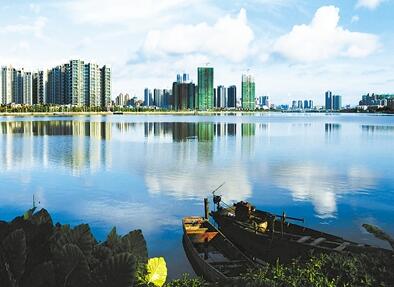 中文PortuguêsEspañolContact Us
中文PortuguêsEspañolContact Us
The 8.3 km Qianshan River, which flows east from Ecao Mt in Qianshan before turning southward toward Macao and the sea, is the oldest geographical feature of Zhuhai and deserves to be called Mother River of the city, according to Wu Liufang, native-born cultural relics collection advisor to the Zhuhai Museum.
Historically, the Qianshan River was under the jurisdiction of Jindou Bay Saltworks in Xiangshan Town in the Tang dynasty (618-907). Centuries later, in the Qing Dynasty (1644-1911), the salt factory was one of the top 13 such salterns in Guangdong Provence. Ancient villages along the riverbanks such as Nanping, Zaobei, Qianshan, Baishi, and Beiling have been habitats of salt workers and their descendants starting from that period. The villagers comprised a high proportion of Zhuhai’s population in the city’s early stages.

Qianshan River [Photo / zhxc.gov.cn]
Qianshan Port has been out of service for 10 years and its ticket hall has become a warehouse for furnishing materials. Located there was the Grain Wharf, which is still being used today for civilian purposes.
Wu pointed out that the river channel once played a major role in development of the Zhuhai area. From 1862 to 1874, local governments dredged the channel from Denglong Mt in Tanzhou Town of Zhongshan City all the way to Macao, forming the rudiment of the Qianshan River Channel. Until the late 20th century, it was a major route of transportation between Zhuhai and Guangzhou. The waterway was heavily used for delivering building materials into the city during the large-scale development period of the last century.

Wu Liufang, right, meets with a river dweller [Photo provided by Wu Liufang]
Wu says that Qianshan made an indelible contribution to Zhuhai by nurturing its earliest aborigines. He suggested that theme seminars be held to explore the history and culture of the river, which may inspire people to further improve the river environment and develop urban construction and culture.
He has written several essays concerning research on the river’s ancient toponym (name origin of a topographical feature), historic sites, and chronicles. In his opinion, the government is duty-bound to build a historical and cultural gallery for performances or exhibitions of historical events such as the sea battle at Shizimen at the end of Southern Song Dynasty (1127-1276), Wen Tianxiang passing the Lingding Sea, and Viceroy Lim banning opium in Xiangshan; and intangible cultural heritages like Shatian Folk Song, Mid-Autumn Antiphonal Singing Fair, and On-Water Wedding related to the river. A patriotic education base featuring the history of modern seaborne trade and land expansion by foreign powers should also be instituted, he proposed.